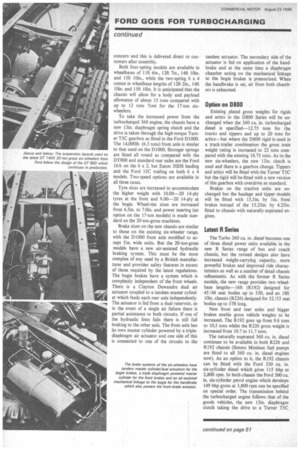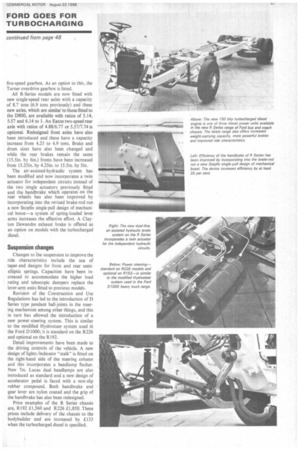Super-safe brakes on these new six-wheelers
Page 49

Page 50

Page 53

If you've noticed an error in this article please click here to report it so we can fix it.
by A. J. P. WILDING, MIMechE, MIRTE FIRST use by Ford of the Turbo 360 diesel is in a new range of six-wheelers for 20-tons-gross operation developed from the current Ford DT800 models. 'The engine is also being introduced as an option in existing Ford D800 rigids and artics and in the latest R Series bus and coach chassis.
The new six-wheelers are called the Ford DT 1400 range and the 20-tons-gross weight limit represents an increase of 3 tons over the DT800 models which have the 128 bhp natUrally-aspirated version of the 360 Cu. in. engine and continue in production.
As with the existing DT800, the new models will be available in three types, a 6 x 2 and a 6 x 4 with four-spring suspension and a 6 x 4 with two-spring suspension. Except for slight modifications the suspensions are the same as on the DT800s and
the four-spring layout, which incorporates interconnected spring rear ends to reduce wheel-hop under braking, is to the design of County Commercial Cars. This concern actually converts chassis supplied by Ford and returns them to pass through Ford's quality-control system. The two-spring model is assembled by Vickers All Wheel Drive from parts supplied by Ford with bogie components manufactured by that concern and this is delivered direct to customers after assembly.
Both four-spring models are available in wheelbases of I [ft 6in., 12ft 7in., I4ft 10in. and 15ft 10in., while the two-spring 6 x 4 comes in wheelbase lengths of 12ft 2in., I4ft 10in. and 15ft 10in. It is anticipated that the chassis will allow for a body and payload allowance of about 15 tons compared with up to 12 tons 7cwt for the 17-ton sixwheelers.
To take the increased power from the turbocharged 360 engine, the chassis have a new 13in. diaphragm spring clutch and the drive is taken through the high-torque Turner T5C gearbox as fitted in the Ford D1000. The 14,000lb (6.3 tons) front axle is similar to that used on the D1000. Stronger springs are fitted all round as compared with the DT800 and standard rear axles are the Ford 16A on the 6 x 2, but Eaton 30DS leading and the Ford I5C trailing on both 6 x 4 models. Two-speed options are available in all three cases.
Tyre sizes are increased to accommodate the higher weight with 10.00-20 14-ply tyres at the front and 9.00-20 I4-ply at the bogie. Wheel-rim sizes are increased from 6.5in. to 7.0in. and power steering (an option on the 17-ton models) is made standard on the 20-ton-gross machines.
Brake sizes on the new chassis are similar to those on the existing six-wheeler range, with the D1000 front axle modified to accept 5in, wide units. But the 20-ton-gross models have a new air-assisted hydraulic braking system. This must be the most complex of any used by a British manufacturer and provides safety features in excess of those required by the latest regulations. The bogie brakes have a system which is completely independent of the front wheels. There is a Clayton Dewandre dual air actuator coupled to a tandem master cylinder which feeds each rear axle independently. The actuator is fed from a dual reservoir, so in the event of a single air failure there is partial assistance to both circuits. If one of the hydraulic lines fails there is still full braking to the other axle. The front axle has its own master cylinder powered by a triplediaphragm air actuator and one side of this is connected to one of the circuits to the tandem actuator. The secondary side of the actuator is fed on application of the handbrake and at the same time a diaphragm chamber acting on the mechanical linkage to the bogie brakes is pressurized. When the handbrake is set, air from both chambers is exhausted.
Option on D800 .
Existing plated gross weights for rigids and artics in the D800 Series will be unchanged when the 360 Cu. in. turbocharged diesel is specified-12.75 tons for the trucks and tippers and up to 20 tons for artics—but where the D800 rigid is used in a truck-trailer combination the gross train weight rating is increased to 22 tons compared with the existing 18.75 tons. As in the new six-wheelers, the new 13in. clutch is used and there is a gearbox change. Tippers and artics will be fitted with the Turner T5C but the rigid will be fitted with a new version of this gearbox with overdrive as standard.
Brakes on the tractive units are unchanged but the haulage and tipper models will be fitted with 15.5in. by 5in. front brakes instead of the 15.25in. by 4.25in. fitted to chassis with naturally-aspirated engines.
Latest R Series
The Turbo 360 Cu. in. diesel becomes one of three diesel power units available in the new R Series range of bus and coach chassis, but the revised designs also have increased weight-carrying capacity, more powerful brakes and improved ride characteristics as well as a number of detail chassis refinements. As with the former R Series models, the new range provides two wheelbase lengths-16ft (R192) designed for • 45/46 seat bodies up to 33ft, and an 18ft 10in. chassis (R226) designed for 52/53 seat bodies up to 37ft long.
New front and rear axles and bigger brakes enable gross vehicle weights to be increased. The R192 goes up from 9.6 tons to 10.3 tons whilst the R226 gross weight is increased from 10.7 to 11.7 tons.
The naturally aspirated 360 cu. in. diesel continues to be available in both R226 and R192 chassis (Simms Minimec fuel pumps are fitted to all 360 cu. in. diesel engines now). As an option to it, the R192 chassis can be fitted with the Ford 330 cu. in. six-cylinder diesel which gives 115 bhp at 2,800 rpm. In both chassis the Ford 300 Cu. in. six-cylinder petrol engine which develops 149 bhp gross at 3,800 rpm can be specified on special order. The transmission behind the turbocharged engine follows that of the goods vehicles, the new 13in. diaphragm clutch taking the drive to a Turner T5C five-speed gearbox. As an option to this, the Turner overdrive gearbox is listed.
All R-Series models are now fitted with new single-speed rear axles with a capacity of 8.7 tons (6.9 tons previously) and these new axles, which are similar to those fitted to the D800, are available with ratios of 5.14, 5.57 and 6.14 to I. An Eaton two-speed rear axle with ratios of 4.88/6.77 or 5.57/7.74 is optional. Redesigned front axles have also been introduced and these have a capacity increase from 4.25 to 4.9 tons. Brake and drum sizes have also been changed and while the rear brakes remain the same (15.5in. by 6in.) fronts have been increased from 15.25in. by 4.25in. to 15.5in. by Sin.
The air-assisted-hydraulic system has been modified and now incorporates a twin actuator for independent circuits instead of the two single actuators previously fitted and the handbrake which operates on the rear wheels 'has also been improved by incorporating into the revised brake-rod run a new Stopfix single-pull design of mechanical boost—a system of spring-loaded lever arms increases the effective effort. A Clayton Dewandre exhaust brake is offered as an option on models with the turbocharged diesel.
Suspension changes Changes to ihe suspension to improve-the ride characteristics include the use of taper-end designs for front and rear semielliptic springs. Capacities have been increased to accommodate the higher load rating and telescopic dampers replace the lever-arm units fitted to previous models.
Revision of the Construction and Use Regulations has led to the introduction of D Series type pendant bail-joints in the steering mechanism among other things, and this in turn has allowed the introduction of a new power-steering system. This is similar to the modified Hydrosteer system used ifi the Ford D1000; it is standard on the R226 and optional on the R192.
Detail improvements have been made to the driving controls of the vehicle. A new design of lights/indicator "stalk" is fitted on the right-hand side of the steering column and this incorporates a headlamp flasher. New 7in. Lucas dual headlamps are also introduced as standard and a new design of accelerator pedal is faced with a non-slip rubber compound. Both handbrake and gear lever are nylon coated and the grip of the handbrake has also been redesigned.
Price examples of the R Series chassis are, R192 <£1,560 and R226 £1,850. These prices include delivery of the chassis to the bodybuilder and are increased by £133 when the turbocharged diesel is specified.




















































































































